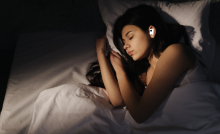Advancements in wearable technology have opened new avenues for monitoring and managing neurological health, particularly for sleep disorder treatment. Insomnia and sleep apnea affect millions worldwide, leading to significant impacts on overall health, cognitive function, and quality of life. Traditional methods for diagnosing and treating these conditions often require cumbersome equipment and clinical settings, which can be inconvenient and inaccessible for many individuals.
The team has developed the first-of-its-kind miniaturized, earworn devices capable of monitoring sleep quality by recording ear-EEG. The devices also offer real-time, closed-loop auditory stimulation designed to enhance deep sleep (slow-wave sleep, SWS) and improve overall sleep quality.
The device:
- Fits comfortably inside the ear, similar in size to an AirPod, ensuring all-night wearability.
- Actively enhances sleep by delivering precise, machine learning (ML)-driven auditory stimulation in real-time.
- Provides multi-modal neural sensing, integrating ear-EEG, eletrodermal activity (EDA), and motion tracking.
- Uses ultra-low-power AI for on-device sleep classification and intervention, eliminating the need for cloud processing.

By combining advanced sensing, real-time AI, and closed-loop neuromodulation, this technology has the potential to transform sleep therapy—providing a safe, comfortable, and effective alternative to drugs and bulky headbands. Moreover, this technology holds significant potential for use in monitoring other diseases and supporting clinical treatments, including epilepsy, Parkinson’s disease, compulsive disorders, and more.
Benefits
Many people suffering from sleep disturbances and neurological conditions face limited treatment choices, often choosing between pharmaceutical approaches—whose side effects and lack of personalization can undermine long-term efficacy—and existing neuromodulation technologies, which are typically bulky, uncomfortable, and poorly suited for continuous everyday use. Conventional approaches also rely on external computing resources, leading to higher power consumption and latency in data processing.
These factors highlight the pressing need for compact, low-power neuromodulation solutions that provide personalized and responsive therapy without sacrificing user comfort or safety. University of Toronto researchers have achieved:
- Comfortable, compact design for long-term wear without bulky components
- High-fidelity biosignal recording with low noise amplification
- Energy-efficient on-chip AI enabling real-time data processing
- Effective treatment of sleep disorders through targeted neuromodulation
- Accurate sleep stage classification models
- Closed-loop auditory stimulation timed with brain activity for enhanced efficacy
- Reduced healthcare costs and improved quality of life for users
- Inclusive design ensuring accessibility and adaptability for diverse users
- Reduced side effects versus pharmaceuticals
Applications
- Sleep disorder treatment
- Sleep monitoring wearable
- Neuromodulation therapy device
- Real-time sleep analysis
- Closed-loop auditory stimulation
- Cognitive enhancement and other behavioural, mental health, and neurological therapies
Status
- IP filed on hardware and software
- Seeking strategic partners for further validation and/ or licensing.





